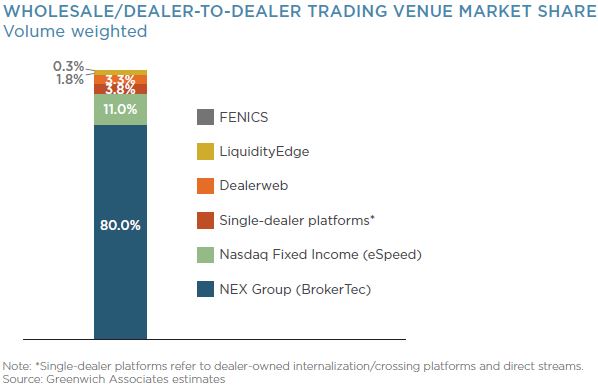Table of Contents
After months—arguably years—of little change in the competitive landscape for trading U.S. Treasurys (UST) electronically, the CME’s acquisition of NEX effectively dropped the yellow flag on the market. Now, like it or not, everyone will need to slow down and take stock of what, where and how they trade.
That’s not to say this wasn’t a genius move for CME and NEX—it was. And ultimately, this could prove hugely beneficial to market participants who will be able to cross-margin future and bond positions, execute multi-leg trades with ease, access better market data than they’ve ever seen before, and likely see access to clearing expanded.
Complexity in the Coupling
However, just as NASDAQ’s acquisition of eSpeed disrupted the status quo, the combination of CME and NEX gives the CME even greater ownership of the U.S. rates market, which might give some market participants pause. There is some validity in that concern, but if you unpack things a little bit more, the pros outweigh the cons.
First, while BrokerTec is the market share leader for wholesale on-the-run UST trading, ahead of Nasdaq Fixed Income and LiquidityEdge, trading between clients and dealers is split between Bloomberg, Tradeweb and the phone. Trading of off-the-run UST is fragmented even more. To take that idea further, a considerable amount of UST trading is also internalized within the major dealers, never finding its way to multi-dealer platforms. So while BrokerTec is an amazing asset for CME, competition for e-trading of UST remains fierce.
Market share estimates as of Q4 2017
Second, we can’t ignore the size and importance of the interest rate swaps market, most of which is traded and cleared away from CME. That said, CME’s cross-margining story between futures and swaps that was and remains compelling for many institutional investors is only more interesting if the UST position can be brought into the picture. This combination of futures and Treasurys was the dream of NYPC about five years ago, an initiative that, for a number of reasons, never gained much traction.
Opportunity in Treasury Clearing
Which brings us to the third and potentially most notable opportunity for the newly combined CME and NEX Group—Treasury clearing. Today FICC exists as the primary option for centrally clearing U.S. Treasurys. They do a great job and certainly reduce systemic risk.
But many smaller broker-dealers and market makers have argued that they are priced out of that service, which severely limits their ability to grow and compete in the marketplace. If CME now comes to market with a solution appealing to that group of market participants, it could have a ripple effect across the entire ecosystem: new entrants, new platforms and more.
And I've only discussed the impact on U.S. Treasury trading as it relates to the acquisition. The addition of EBS to the CME arsenal could have similar, albeit less dramatic, impacts and the impressive post-trade product line that includes Traiana and TriOptima could give a further boost to CME's trade processing and clearing businesses.
The behavior of capital markets and their participants are notoriously hard to predict, and the best or most logical outcome is not always the result. But in this case one thing is undisputed: CME's purchase of NEX Group is game-changing—we just don't know exactly how the game will change.


